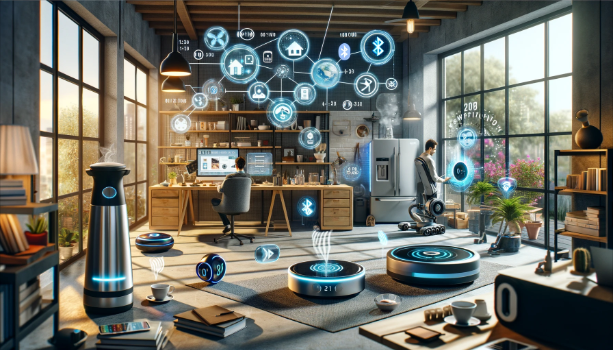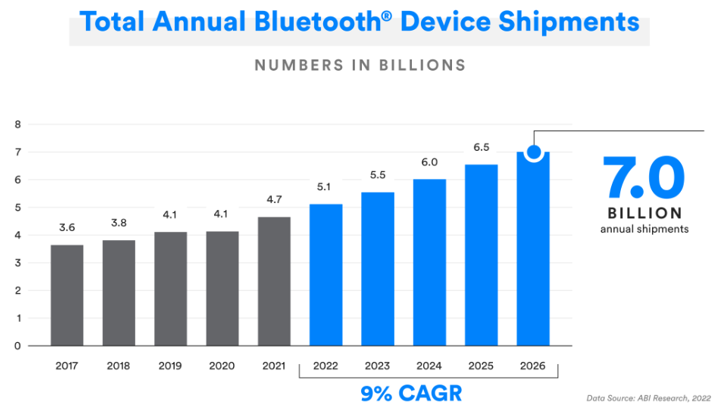|
Bluetooth IoT
We have long been using Bluetooth just as a technology to connect our headsets, wireless mice, and keyboards to our mobile phones or PCs, but the technology does not stop there. In the vast world of the Internet of Things (IoT), Bluetooth has taken on a crucial role. It helps devices communicate with each other more easily, making our homes smarter, our health monitoring more efficient, and our workplaces more productive. In this note, we will explores how Bluetooth is expanding its reach
beyond simple connections, bringing benefits and facing challenges as it shapes the future of how our devices interact.

In this note, I am going to talk about how WiFi is used for IoT and overcome various technical challenges for the application.
Today, using Bluetooth to connect different devices is a normal part of our lives, not something from a science fiction story. Around us, there are many kinds of devices that use Bluetooth to talk to each other. This makes our homes smarter, keeps us healthy, helps us work better, and even makes fun outdoor activities better. The table below shows many Bluetooth devices we might use every day. You'll see things for your house, for staying healthy, for driving, and even for big factories. These
examples help us see how Bluetooth is everywhere, making things easier and more fun for us right now, not just in the future.
|
Category
|
Bluetooth IoT Devices
|
Description
|
|
Smart Home
|
Smart locks
|
Enable keyless entry and remote access through smartphones.
|
|
|
Smart thermostats
|
Allow remote temperature control and energy savings.
|
|
|
Wireless speakers
|
Provide high-quality audio streaming from mobile devices.
|
|
|
Smart lighting systems
|
Offer remote and automated control of home lighting.
|
|
|
Smart TVs
|
Enable streaming and smart features through Bluetooth connectivity.
|
|
Health/Fitness
|
Fitness trackers
|
Monitor physical activity and health metrics.
|
|
|
Wireless heart rate monitors
|
Track heart rate in real-time for fitness and health monitoring.
|
|
|
Smart health scales
|
Measure and track body weight and composition data.
|
|
|
Blood pressure monitors
|
Offer convenient at-home blood pressure monitoring.
|
|
|
Sleep trackers
|
Analyze sleep patterns for better sleep quality.
|
|
Outdoors
|
GPS trackers
|
Track the location of objects or individuals outdoors.
|
|
|
Outdoor lighting
|
Control outdoor lights remotely for convenience and security.
|
|
|
Smart bike locks
|
Secure bikes with features like remote locking/unlocking.
|
|
|
Portable weather stations
|
Provide real-time weather data from remote locations.
|
|
Automobile
|
Wireless car diagnostics tools
|
Diagnose car issues wirelessly with a smartphone.
|
|
|
Keyless entry systems
|
Allow drivers to unlock their cars without a physical key.
|
|
|
Tire pressure monitoring systems
|
Monitor and report the vehicle's tire pressure.
|
|
|
Bluetooth vehicle trackers
|
Track a vehicle's location and status information.
|
|
Industry
|
Asset tracking tags
|
Track and manage assets in real-time within industrial settings.
|
|
|
Machine condition monitoring sensors
|
Monitor the health and performance of industrial machinery.
|
|
|
Smart safety equipment
|
Enhance worker safety with features like fall detection.
|
|
|
Environmental monitoring sensors
|
Track environmental conditions like temperature and humidity.
|
The demand for Bluetooth-connected devices in the Internet of Things (IoT) industry is booming, with shipments projected to reach a staggering 7 billion units by 2026. This graph from ABI Research illustrates this upward trajectory, highlighting the significant growth of Bluetooth shipments year-over-year. Let's delve into the statistics and explore the factors driving this trend.

Source : 2022 Bluetooth® Market Update
The graph paints a clear picture of the rapid growth in the Bluetooth IoT sector. It shows that the total annual shipments of Bluetooth devices have been rising steadily from 2017 and are projected to continue this trend into the future. In 2020, there was a notable increase to 4.7 billion shipments, and this momentum appears to be carrying forward with an anticipated 7 billion devices to be shipped annually by 2026. This represents a Compound Annual Growth Rate (CAGR) of 9%, highlighting the
significant, sustained demand for Bluetooth-enabled devices. Such statistics underscore the integral role Bluetooth technology plays in the expanding IoT landscape, reflecting its wide adoption across various applications for both personal and commercial use.
NOTE : Check out 2022 Bluetooth® Market Update for more details statistics in terms of sector breakdown and statistics for each sector.
Do we need a specific variants of Bluetooth for IoT ? or is it same as regular Bluetooth ?
While standard Bluetooth Classic can be used for some IoT applications, a specific variant called Bluetooth Low Energy (BLE) is generally preferred and much more widely used in IoT.
For most IoT applications, Bluetooth Low Energy offers significant advantages in power consumption, connection efficiency, and range extension due to mesh networking. Bluetooth Classic finds its place in IoT for its higher data transfer abilities or supporting older devices.
- Bluetooth Low Energy (BLE): The IoT Favorite
- Power Efficiency: BLE is designed for significantly lower power consumption, allowing devices to operate for months or even years on small batteries. This is crucial for devices like sensors that need to stay powered for extended periods.
- Simplified Connections: BLE simplifies device discovery and connection processes, making it easier for IoT devices to establish quick connections with smartphones and other gateways.
- Beacon Technology: BLE powers beacon technology, used for indoor location tracking, proximity marketing, and asset management within the IoT space.
- Mesh Networking: BLE supports mesh networking, allowing devices to form self-organizing networks and extend range – beneficial for large-scale IoT deployments.
- Bluetooth Classic: When and Why
- High-Bandwidth Needs: Bluetooth Classic remains better when you need higher data rates, such as streaming audio or transferring large files.
- Legacy Compatibility: Some older devices may only support Bluetooth Classic, thus providing backward compatibility.
Bluetooth is a key part of the Internet of Things (IoT), which is all about connecting different devices so they can work together. However, using Bluetooth for IoT isn't always easy. In this section, we will take a look at the tough parts of making Bluetooth work well in IoT. We're talking about making sure devices can always connect without problems, keeping data safe from hackers, and making sure devices don't run out of battery too fast.
- Limited Range
- Challenge: Even with enhancements, Bluetooth (and especially BLE) still operates over a relatively short-range compared to other wireless technologies like Wi-Fi.
- Description: This range limitation might hinder large-scale IoT deployments in warehouses, industrial settings, or smart cities where devices need to communicate over greater distances.
- Possible Solutions:
- Mesh Networking (BLE): Devices act as relays, extending network coverage
- Increasing Transmitter Power: While improving range, this leads to greater power consumption.
- Security Concerns
- Challenge: Bluetooth security has had various vulnerabilities historically, and maintaining security as the technology evolves remains a concern.
- Description: Potential risks include device spoofing, man-in-the-middle attacks, eavesdropping, and unauthorized access. This is paramount as IoT networks can carry sensitive data.
- Possible Solutions:
- Robust Encryption and Authentication: Using standards like AES-128.
- Secure Pairing: Employing methods like Numeric Comparison or Out-of-Band (OOB) pairing.
- Regular Updates: Ensure devices receive necessary security patches.
- Interference and Coexistence
- Challenge: The 2.4 GHz frequency band used by Bluetooth is also crowded with Wi-Fi, Zigbee, and other wireless technologies, leading to potential interference.
- Description: Interference can cause disrupted connections, data loss, and reduced performance in Bluetooth IoT devices.
- Possible Solutions:
- Frequency Hopping: Allows Bluetooth devices to dynamically switch channels, mitigating interference.
- Careful Planning: Analyze the wireless environment and place devices strategically to reduce signal clashes.
- Scalability
- Challenge: Managing and coordinating vast numbers of Bluetooth IoT devices presents scalability challenges, especially in large deployments.
- Description: Issues can arise with device discovery, connection management, and data traffic coordination as the network size grows.
- Possible Solutions:
- Mesh Networking: Distributes connection management, easing centralized congestion.
- Cloud-Based Management: Cloud solutions enable remote management and monitoring of a huge number of devices.
- Interoperability
- Challenge: While Bluetooth has standards, device-level variations and custom profiles might cause complications between different manufacturers' devices.
- Description: Difficulties ensuring seamless communication and functionality among IoT devices from different vendors.
- Possible Solutions:
- Strict Adherence to Standards: Promote interoperability by encouraging thorough and uniform adoption of standard Bluetooth profiles.
- Compatibility Testing: Before deployment, carefully test interactions between devices.
- Pairing and Connectivity Issues
- Challenge: The pairing process between Bluetooth devices can sometimes be unreliable or complex, especially for non-technical users. Connectivity can also be affected by environmental factors or software glitches.
- Description: These issues create frustration, hindering user experience, and delaying the full benefits of IoT devices.
- Possible Solutions:
- Simplified Pairing Methods: Employ intuitive pairing processes (QR codes, NFC).
- Robust Connection Management: Software designed for automatic reconnection in case of interruptions.
- User-friendly troubleshooting steps within apps or device interfaces.
- Power Consumption
- Challenge: While BLE is low-energy, power consumption is still a factor. IoT devices are often battery-powered and expected to have long lifespans.
- Description: Battery drain impacts device longevity, maintenance frequency, and overall user experience.
- Possible Solutions:
- Optimized Protocols: BLE uses power-efficient modes and protocols.
- Power-Aware App Development: Software and applications should make optimized Bluetooth usage a priority.
- Hardware Power Enhancements: Battery technologies and energy-efficient components reduce overall consumption.
- Data Throughput
- Challenge: Bluetooth, especially BLE, has a lower data throughput in comparison to Wi-Fi or cellular technologies.
- Description: This limit affects applications requiring frequent transmission of large amounts of data (i.e., high-quality audio/video streaming).
- Possible Solutions:
- Compression Techniques: Efficiently compress data before transmission.
- Choosing the Right Technology: When high throughput is essential, Bluetooth might be paired with or replaced by other suitable options.
- Latency
- Challenge: Bluetooth can exhibit some latency (delay between input and action), affecting real-time applications.
- Description: Even small delays can disrupt user experience in scenarios requiring fast response times (e.g., some gaming applications, industrial control).
- Possible Solutions:
- Prioritizing Time-Sensitive Data: Implement QoS (Quality of Service) measures to give certain data priority.
- Optimized BLE Software Stack: Ensure a software stack designed to minimize latency.
Reference
|
|

